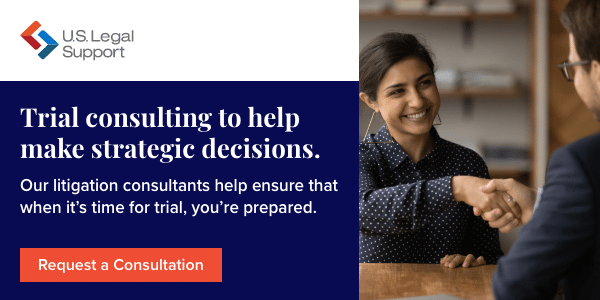Trial Readiness 2026: Trends Shaping Winning Litigation

As litigation becomes increasingly data-driven and digitally connected, trial services are undergoing transformation.
U.S. Legal Support’s 2026 Litigation Support Trends survey reveals that firms are investing heavily in trial technology, visual strategy, and hybrid courtroom readiness. With AI and remote participation tools now central to case preparation, the 2026 legal landscape will emphasize integration, efficiency, and storytelling through technology.
Below, we’ll examine how law firms are using trial services to enhance persuasion, efficiency, and collaboration, and what these changes mean for trial preparation, presentation, and overall litigation strategy in 2026. This includes trial graphics, animations, illustrations, 3D models, and other media, jury consulting and research, and trial presentation management and support.
Who We Surveyed in 2025
We collected responses to a 70-question survey covering the trends, challenges, and plans for the upcoming year. Our 2,011 respondents’ origins broke down to:
- 72% from single-market or regional law firms
- 17% from AmLaw 100 firms
- 4% from Fortune 1000 organizations
- 7% indicated “other”
Respondents identified their role as:
- Legal Assistant (33.17%)
- Paralegal (31.48%)
- Attorney (6.81%)
- Associate Attorney (5.67%)
- Partner (4.82%)
- Managing or Senior Partner (4.33%)
The remaining respondents represented smaller slices, in addition to 5% noting “other”:
- Case Manager (2%)
- Calendar Clerk (2%)
- General Counsel (1%)
- In-House Counsel (1%)
- Chief Litigation Officer/Legal Executive (1%)
- Legal Operations (2%)
Respondents worked in various practice areas and specialties, with the highest concentrations in:
- Personal Injury (39%)
- Insurance (28%)
- Medical Malpractice (17%)
- Labor and Employment (14%)
- Construction (13%)
- Contracts (13%)
In addition to these practice areas, we also heard from legal professionals specializing in real estate, product liability, class actions, intellectual property disputes, environmental law, securities fraud, and many other areas.
Low Trial Volume, High‑Tech Execution
It’s been long established that plea bargains and settlements vastly outweigh resolutions by trial across case types and jurisdictions, which means that cases that reach the courtroom often come with big stakes.1,2,3
2025 Key Findings
Here’s what we found when we asked about trial frequency, support, and tactics experienced in 2025:
- Most matters resolve before trial – 42% of respondents say they try <10% of cases in court each year (vs. 44% in 2024). This question measures the share of matters that go to trial.
- In-court tech support – 30% of respondents rely on paralegal or other support staff for in-court technology support.
- Visual strategy is mainstream – 37% use a legal graphics partner for demonstratives/animations, and 41% have conducted a mock trial or focus group prior to going to trial.
Forward Look to 2026
Expect continued expansion of hybrid components in trial work: 44% anticipate an increase in remote depositions, and 35% believe virtual mediations, arbitrations, and trials will also rise. This pressures teams to integrate remote testimony, synced transcripts, and digital exhibits seamlessly on trial day.
Visual Strategy Becomes a Core Advocacy Skill
Decades of cognitive research show that visuals and memory are tightly linked. Effects like picture superiority and dual-coding demonstrate that concepts presented with well-designed visuals are understood faster and remembered longer than words alone.4
Audiences are as much as 22 times more likely to absorb and retain information that’s offered in a compelling story format over dry facts.5 The use of storytelling has been shown to trigger neurological sparks that enhance empathy, emotion, and engagement.
Visuals are critical to storytelling, too, particularly when supported by legal graphic professionals who can leverage sophisticated design elements to:
- Identify key characters
- Introduce emotional themes
- Connect events narratively
- Provide consistency and through-line motifs
And of course, trial graphics and demonstratives help provide clarity when it comes to portraying medical and scientific information as well as actions and events.
2025 Key Findings
We asked about the origin of trial graphics, vendor balance, and whether graphics were tested prior to the start of a trial:
- Prevalence of graphics vendors – 37% of firms use legal graphics partners for demonstratives, animations, and other imagery.
- Number of graphics vendors engaged – 38% limit trial graphics and exhibits outsourcing to two to four vendors, and 14% stick with a single graphics partner. 12% use five to 10 vendors, 6% deal with a whopping 11 or more vendors, and the remaining 28% handle graphics internally or don’t utilize them.
- Use of mock trials and focus groups – 38% conduct mock trials or focus groups to refine their case themes, graphics, and storytelling before entering the courtroom.
Forward Look to 2026
Expect wider use of data visualization, medical illustrations and animations, 3D reconstructions, and interactive exhibits to simplify complex cases. Attorneys will work hand-in-hand with trial graphics experts to craft visual narratives that resonate with tech-savvy juries.
In 2026, compelling visuals aren’t an enhancement; they’re an expectation. Effective storytelling through design will define courtroom impact.
AI and Predictive Tools Enhance Trial Preparation
The involvement of AI in the legal industry may benefit a wide range of legal tasks, from automating repetitive and cumbersome discovery and administrative steps to providing new insights, connections, and predictions.
Leveraging predictive data analytics to establish outcome likelihoods has significant potential for firms, providing for:
- Pattern identification to refine arguments, approaches, and demonstratives
- Outcome analysis using multiple variables to benefit case strategy
- Enhanced risk assessment at the initial case acceptance or refusal stage
- Integration of data to better predict specific jurisdiction outcomes
- Finding compliance and regulatory issues, legal risks, conflicts of interest6
2025 Key Findings
We asked about who was using what technology—and for what purpose—as well as what respondents anticipated around the bend.
- AI in trial prep – 38% selected trial preparation and strategy as a top area where AI may have the most impact over the next five years.
- Predictive analytics – For predictive analytics specifically, 18% have used it; 9% plan to in 2026; 72% have not used it yet.
- AI adopters – 43% stated they’re currently using AI tech. Among AI users, relevant trial‑adjacent tasks include transcript/record summarization (17%), litigation analysis (13%), and predictive analysis (13%).
- Technology tools wish list – 22% want to see both predictive analytics and generative AI better integrated into litigation workflows, while 31% vote for AI case chronology generators.
Forward Look to 2026
Firms can leverage AI to simulate case outcomes, analyze jury sentiment, and identify evidentiary gaps. Predictive analytics will evolve from discovery support to real-time trial strategy tools, helping teams prepare more efficiently.
AI’s role in trial work is shifting from background research to active decision-making. In 2026, data intelligence will shape every step of courtroom preparation.
Legal Operations Bridge Strategy and Technology
An effective legal operations team can lead the way when new technology is part of an organization’s strategic planning. While historically, legal operations were a function found within in-house legal departments, it’s a growing standard for law firms that recognize the need to adapt and align their teams with business planning.
In addition to a focus on efficiency and the business of law, a legal operations team may cover:
- Strategic planning
- Financial management
- Budgeting
- Data analytics
- Knowledge management
- Compliance
- Vendor relations
- Contract management
2025 Key Findings
We inquired about the prevalence of formal legal operations teams and asked respondents to comment on their top investment priorities for 2026.
- Legal ops in firms – 46% of firms now have a dedicated legal operations department, ensuring cohesive technology management and resource allocation.
- 2026 investments – Top priorities include data management, AI/machine learning, and cybersecurity.
Forward Look to 2026
Legal operations will continue driving transformation, centralizing workflows across trial preparation, evidence management, and billing. Operational efficiency will increasingly depend on aligning human expertise with integrated technology.
Legal operations will be the engine of litigation modernization in 2026, connecting teams, tools, and data to deliver strategic efficiency.
Training and Talent Modernization Become Critical
It’s critical that humans play a key role in the adoption of technology, particularly in the use of AI. Talent search criteria, cohesive and top-down internal messaging, and high-quality training are all elements to build into a tech-forward legal team.
2025 Key Findings
Training is behind, and it’s a significant factor in delaying tech adoption:
- Training lags – Only 35% of firms provided formal technology or AI training to staff in 2025.
- Change resistance – Many cite human oversight and limited training as ongoing challenges to effective tech adoption.
Forward Look to 2026
As technology becomes inseparable from trial practice, firms will invest in training programs, certifications, and cross-functional teams. Litigation support specialists, paralegals, and trial technicians will collaborate closely to ensure courtroom readiness.
Consider engaging litigation support partners who can provide:
- Court reporters, transcriptionists, etc., who are skilled in remote participation
- Access to remote deposition and exhibit sharing tools
- Trial technology specialists for hands-on management during complex cases
- Scalable services for time-critical court dispositions
- Trial-ready graphics, animations, and illustrations to help tell your case story
The future trial team is tech-enabled and cross-disciplinary. Continuous learning will become the foundation of successful trial operations in 2026.
Are You Ready for the Future of Trial Readiness?
The 2025 data supports a clear trajectory, with trial preparation and execution evolving toward a fully digital, hybrid model. As firms head into 2026, success will hinge on visual communication, AI integration, and operational cohesion. Those who invest in strategic partnerships, technology, training, and strategy alignment will be best positioned to deliver results in the courtroom of the future.
U.S. Legal Support’s trial services team, TrialQuest, brings together expert consultants, visual design, and cutting-edge technology to empower firms in every phase of litigation. Partner with us to elevate your trial strategy and stay ahead of 2026’s courtroom transformation.
Sources:
- American Bar Association. Fourteen Principles and a Path Forward for Plea Bargaining Reform. https://www.americanbar.org/groups/criminal_justice/resources/magazine/2024-winter/fourteen-principles-path-forward-plea-bargaining-reform/
- NPR. The vast majority of criminal cases end in plea bargains, a new report finds. https://www.npr.org/2023/02/22/1158356619/plea-bargains-criminal-cases-justice
- The Law Dictionary. What Percentage of Lawsuits Settle Before Trial? What Are Some Statistics on Personal Injury Settlements? https://thelawdictionary.org/article/what-percentage-of-lawsuits-settle-before-trial-what-are-some-statistics-on-personal-injury-settlements/
- Lightbulb Moment. “65 percent of people are visual learners” is lazy journalism. https://lightbulbmoment.info/2018/11/03/65-percent-of-people-are-visual-learners-is-lazy-journalism/
- Marketing Words. Storytelling Statistics: Why Marketing Storytelling Works So Well. https://blog.marketingwords.com/storytelling-stats/
- Cacti Global on LinkedIn. Legal Decision-Making with Predictive Analytics. https://www.linkedin.com/pulse/legal-decision-making-predictive-analytics-cactiglobal/

Editoral Policy
Content published on the U.S. Legal Support blog is reviewed by professionals in the legal and litigation support services field to help ensure accurate information. The information provided in this blog is for informational purposes only and should not be construed as legal advice for attorneys or clients.


